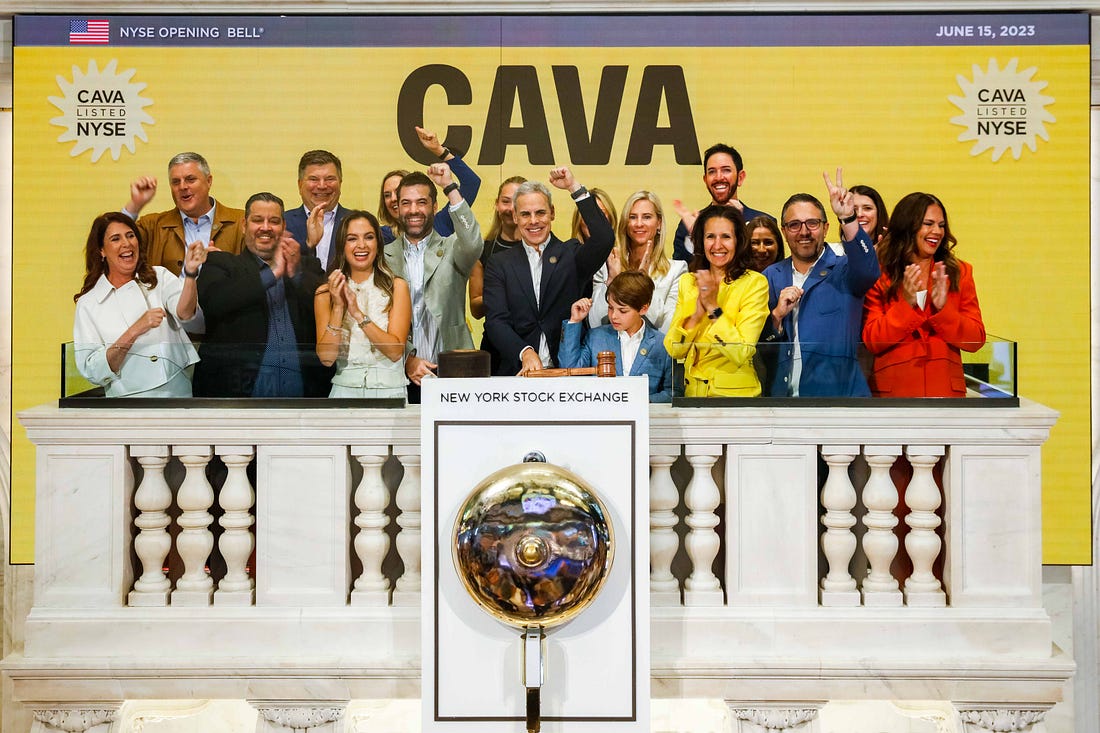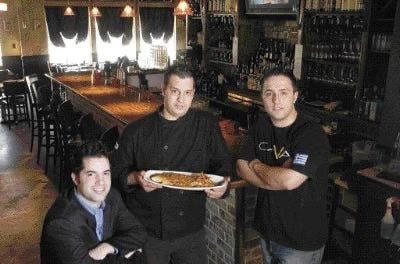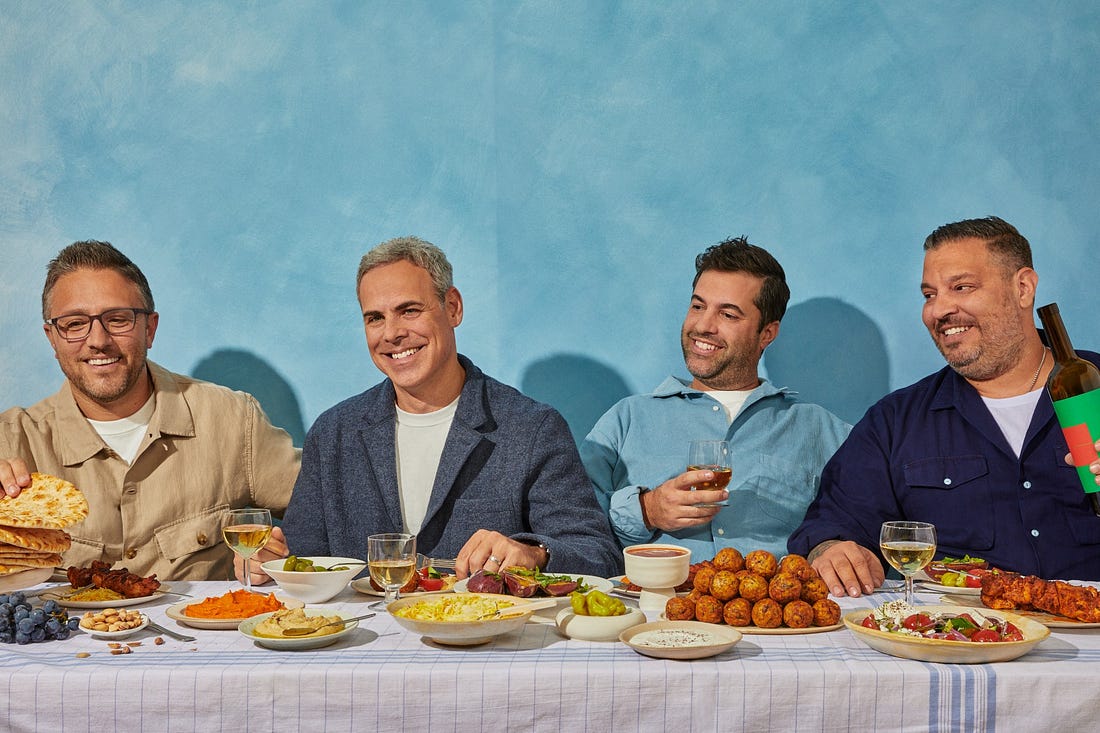How CAVA’s Founders Built a $15-Billion Fast-Casual Empire
How CAVA’s Founders Built a $15-Billion Fast-Casual EmpireCAVA co-founder Ted Xenohristos shares his insights on constant iteration, building a brand people love, and knowing when to step aside to let an expert take the reins.
This Q&A is part of The Profile’s new series, ‘BUILT FROM SCRATCH: Conversations with founders who created something out of nothing.’ My goal is to make the Q&As as practical as possible. Any and all feedback is welcome. — In 2006, Ted Xenohristos and his two friends, Ike Grigoropoulos and Dimitri Moshovitis, launched their first business—a Greek restaurant in Rockville, Maryland. That restaurant, CAVA Mezze, was a small, independent venture. Today, you likely know CAVA as a dominant player in the fast-casual space, with a market cap of $15 billion. But its origins were far more humble. The three friends, all of Greek heritage, wanted to create a restaurant that honored the traditions they grew up with—the flavors, recipes, and hospitality of home. “We would travel to Greece every so often, and I would see this amazing food,” Xenohristos told The Profile. “Mediterranean food is all about the quality of the ingredients and the simplicity of the food.” And so, CAVA Mezze was born. Xenohristos worked as the server and bartender, Moshovitis ran the kitchen, and Grigoropoulos handled the accounting. None of them had experience running a restaurant, and the challenges came fast. To fund the venture, they maxed out their credit cards, took over the lease of a former Russian bakery, and moved back in with their parents to save money. Every day was chaos—orders scribbled on sticky notes, incorrect pricing, and portion sizes that left some customers bewildered. “We had no register or POS system, so we did everything by hand and with calculators,” Xenohristos says. “It was always so chaotic.” But the chaos was overshadowed by their hospitality. They didn’t have a marketing budget, but word spread that CAVA Mezze treated its guests like family. Extra food, complimentary drinks, dips to take home — small gestures that cost money but built immense goodwill. “To me, it was a natural instinct,” Xenohristos said. “It wasn’t a plan we put together. This was hospitality.” As the business grew, the founders recognized they needed help. In 2010, they brought in former finance executive Brett Schulman as CEO. Under his leadership, CAVA expanded into consumer packaged goods, refined its fast-casual concept, and ultimately went public. In this Q&A, Xenohristos shares his insights on constant iteration, building a brand people love, and knowing when to step aside to let an expert take the reins. This Q&A has been lightly edited for clarity and length. — How did you guys get the initial funding for the CAVA Mezze restaurant?XENOHRISTOS: We maxed out our credit cards. We waited tables during the day, and for $20,000, we managed to build out the restaurant. We did the plumbing ourselves. We did the electricity ourselves. We almost died many times because we did not know what we were doing. We just never gave up. There were so many moments where we had to open, we had to pay rent, but we were just working as waiters, and we were paying the landlord whatever money we made. We moved in with our parents. We had no sign — we couldn’t afford it. We had no register or POS system, so we did everything by hand and with calculators. It was always so chaotic. With a $20,000 investment that first year, how much did you do in revenue?I can’t remember the exact numbers, but we eventually got to a point where we were doing close to $2 million in revenue. Wow. Can you elaborate on how you got there?We managed to pay off the restaurant, but here’s the problem we ran into: None of us had run a restaurant before, so we didn’t know anything about food costs. We were selling scallops and octopus, so we would buy 20 pounds of octopus, but then when you boil it down, there’s only like eight pounds left. We were losing money left and right. The same thing happened with lamb chops. So we were good revenue-wise, but we weren’t really making any profit. Things started to change when Ike, one of my partners, started doing more of the financial stuff. He’s an accountant by trade, and once he started doing it, we started making money. And that led to the idea of opening a second location. Have the challenges you’ve faced shaped your mentality in a way that makes you less emotionally volatile? How do you approach setbacks now?I think being Greek I’ll always be volatile. I always wanted to do something I love and enjoy. I’m not a person that would ever give up, and I know that if I did, I would have to go work construction like my dad to make money. So I wanted to bust my ass no matter what. I didn’t want to give up. I didn’t want to stop — none of us did. We just felt like there were no other options for us. I didn’t graduate from university. I didn’t have a fallback plan. My fallback plan was to go be a waiter at another restaurant. So I’m like, ‘If I’m gonna go do that, I might as well be a waiter at my own restaurant.’ We didn’t act like owners. We didn’t walk around, just drinking wine, and hanging out. I mean, we worked. I was a waiter, and I was bartending. Dimitri was in the kitchen cooking. Like we worked for that restaurant for years. We would sleep at it sometimes. It’s that immigrant mentality — watching my mom leave at 6 a.m. to get to a place that opens at 8, right? Seeing that, how can I whine about going to my restaurant that I own, you know? There’s no room to whine. You have no right to whine. For more like this, check out ‘How Eight Sleep Co-Founder Alex Zatarain Built a Company That Pioneered the ‘Sleep Fitness’ Category‘ At some point, customers started asking to buy your restaurant’s dips in larger quantities. How did this inspire you to expand your business into grocery stores?People kept coming in and asking us, ‘How do I buy hummus in bulk?’ I can’t even tell you how much hummus we were making. We were filling up quart containers, pint containers with hummus and tzatziki. We had a customer one time who told us, ‘You guys should sell this in the grocery store.’ And I’m like, ‘Who has time? I don’t have any time for this.’ At that point, we were building our second restaurant in D.C, and and we eventually decided to do it because that customer said he would help us with opening accounts at the grocery store. He would go to a Whole Foods and say, ‘We have these dips and spreads. We’d like to sell them here.’ It was different in the grocery business back then because you could walk into Whole Foods, and there were buyers individually within those stores who could just say ‘yes’ to your product. We would make those dips and spreads in the restaurant, and we would operate the restaurant literally all day and night. We’d sit in that kitchen from midnight until 4 a.m, and Dimitri would be making dips in the back. We would hand scoop them on little scales. We would put the top on with a plastic seal, and we would use these blow dryers to get the seals on. Then, the dips went into coolers, and then we’d make deliveries at 7 or 8 a.m. to the grocery store. When I tell you we slept there, we slept there. It was a brutal time because we didn’t really understand we were doing. I mean, it was growing. It grew so much that we had to get a facility because we couldn’t make it in the restaurant anymore. Our customer Ken helped us grow the business to a point where it outgrew him, and it outgrew us. We didn’t understand the logistics of grocery business and production. That’s where Brett [Schulman] comes into the fold. (Editor’s Note: At the time, Brett Schulman had just had a four-year stint as CEO for Snikiddy Snacks, a healthy snack company started by his wife and mother-in-law.) Tell me why you decided to bring Brett on board as a partner.It had been about three years of operating our restaurants and making our dips. With Brett, I essentially hired the guy who was going to be my boss. He was the person I was going to be reporting to. It went like this: He found our dips and spreads after he saw them in the grocery store. He knew my cousin and her husband really well, so he asked them, ‘Do you know these guys?’ And they said, ‘Yes, and they need a lot of help. They’re struggling with the grocery business.’ He reached out to me, we connected, and I told him all the problems we were having with the product. He had some experience with the snack company, Snikiddy Snacks, which he and his wife built from the ground up. I told him, ‘I can’t pay you. I don’t have any money, but if you help us fix this business, I’ll just give you a percentage of it.’ What exactly was he doing?He was focused on how we were producing our product, how we were delivering it, and the cost of the production. He understood the grocery network. He understood what was the best way to get the product into the grocery stores, how to work with grocery stores to brand your product, and how to get it on the right shelf. So Brett and I hit it off. It was just an instant connection, and we saw the world the same way. We saw the future the same way. We were talking about this new concept of doing something different from the full-service restaurant. We agreed to do this new project, and then we never looked back. I went to him, and I said, ‘I feel like I have a good read on you, and my read is that I want you to be our fourth partner. We’ll give you 25% of everything.’ He would come on as a fourth partner and we would each give up 8%, and he would get 25%. His response was, ‘I just want to be a good partner to you, and that’s not a good proposition you want to make in the business world.’ But that’s how I’ve always done it. Dimitri, Ike, and I were equal partners, and there was never any inequality, so I didn’t want that for this. We shook hands, and we set out to do the CAVA Grill concept that we all know today. Brett joined as CEO, and he led CAVA to its initial public offering in 2023. How did that moment feel for you — seeing this tiny company you started go public on the New York Stock Exchange?It was amazing. I was talking to my dad, a guy who came from this little village in Greece to America with a dream of just having a better life, and now his son is ringing the bell at the at the New York Stock Exchange. I mean, it was emotional. I can’t explain it. You can’t put it into words. Are there any practical lessons from everything you’ve learned that you’d like to share with young entrepreneurs who are just starting out and aiming to do something big?It’s a cliché, but it’s the only advice I can give: You have to not give up, and you always have to be able to adapt. You always have to be able to listen to your customers. Then, when you’re actually in the process of building something big, it’s about bringing in people who are smarter and more knowledgeable than you. To sit here and ever think that I’m the smartest person in the room would be my instant downfall. I love looking around, and thinking, ‘I’m probably the least smart person in this room.’ I definitely think that the only way to build a business is to listen to your customers, bring in smart people, and have the ability to never give up. Key takeaways:
… For more like this, make sure to sign up for The Profile here:✨ Order my book, HIDDEN GENIUS below:You’re currently a free subscriber to The Profile. For the full experience, upgrade your subscription.
© 2025 The Profile |




